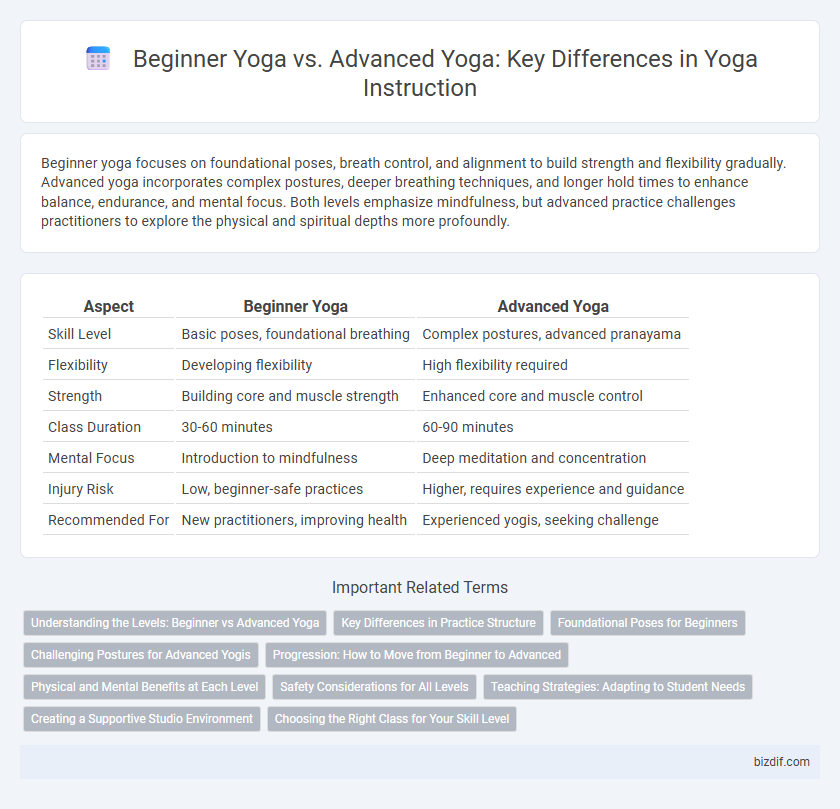Beginner yoga focuses on foundational poses, breath control, and alignment to build strength and flexibility gradually. Advanced yoga incorporates complex postures, deeper breathing techniques, and longer hold times to enhance balance, endurance, and mental focus. Both levels emphasize mindfulness, but advanced practice challenges practitioners to explore the physical and spiritual depths more profoundly.
Table of Comparison
| Aspect | Beginner Yoga | Advanced Yoga |
|---|---|---|
| Skill Level | Basic poses, foundational breathing | Complex postures, advanced pranayama |
| Flexibility | Developing flexibility | High flexibility required |
| Strength | Building core and muscle strength | Enhanced core and muscle control |
| Class Duration | 30-60 minutes | 60-90 minutes |
| Mental Focus | Introduction to mindfulness | Deep meditation and concentration |
| Injury Risk | Low, beginner-safe practices | Higher, requires experience and guidance |
| Recommended For | New practitioners, improving health | Experienced yogis, seeking challenge |
Understanding the Levels: Beginner vs Advanced Yoga
Beginner yoga emphasizes foundational poses, alignment, and breath awareness to build strength and flexibility safely for new practitioners. Advanced yoga incorporates complex postures, inversions, and deeper pranayama techniques requiring greater balance, strength, and mental focus. Understanding these levels helps tailor practice intensity, preventing injury and promoting steady progress.
Key Differences in Practice Structure
Beginner yoga classes emphasize foundational poses, alignment, and breath control, allowing practitioners to build strength and flexibility gradually. Advanced yoga sessions incorporate complex postures, dynamic flows, and extended holds that challenge balance and endurance. The practice structure in advanced classes often includes deeper meditation and pranayama techniques, enhancing both physical and mental discipline.
Foundational Poses for Beginners
Beginner yoga emphasizes foundational poses such as Downward Dog, Mountain Pose, and Child's Pose to build strength, flexibility, and proper alignment. These essential postures serve as the groundwork for advanced practices, which involve more complex poses requiring increased balance, stamina, and body awareness. Mastering beginner poses reduces injury risk and enhances overall yoga progress, setting a solid base for advanced techniques.
Challenging Postures for Advanced Yogis
Advanced yoga incorporates challenging postures such as arm balances, deep backbends, and complex inversions that require strength, flexibility, and precise alignment. These poses deepen body awareness and enhance mental focus, distinguishing advanced practice from beginner routines centered on foundational poses and gentle stretching. Mastery of challenging postures demands consistent practice and a strong understanding of anatomy to prevent injury and maximize benefits.
Progression: How to Move from Beginner to Advanced
Beginner yoga focuses on foundational poses, breathing techniques, and building body awareness, essential for developing strength and flexibility safely. Progressing to advanced yoga requires consistent practice, mastering alignment, and gradually increasing pose complexity and duration to enhance balance, endurance, and mental focus. Tracking improvements through personalized routines and incorporating challenges like inversions or arm balances accelerates skill development and prevents injury.
Physical and Mental Benefits at Each Level
Beginner yoga emphasizes foundational poses that improve flexibility, balance, and muscle strength, helping practitioners develop body awareness and reduce stress through mindful breathing. Advanced yoga incorporates complex postures and challenging sequences that enhance core strength, endurance, and mental focus, promoting deeper meditation and emotional resilience. Both levels contribute uniquely to physical health and mental clarity, with beginners building essential skills and advanced practitioners refining control and inner calm.
Safety Considerations for All Levels
Safety considerations in beginner yoga prioritize proper alignment, gentle progressions, and avoiding overstretching to prevent injury. Advanced yoga demands heightened body awareness, controlled breathing techniques, and mindful transitions to safeguard joints and muscles during complex poses. Both levels benefit from attentive instruction, use of props, and regular adjustments to maintain a safe practice environment.
Teaching Strategies: Adapting to Student Needs
Teaching strategies in beginner yoga prioritize foundational alignment, breath awareness, and gentle progression to build confidence and prevent injury. Advanced yoga instruction emphasizes refining postures, incorporating complex sequences, and deepening mindfulness to challenge students' strength, flexibility, and focus. Tailoring practices to individual capabilities and goals ensures safe progression and maximizes each student's growth in their yoga journey.
Creating a Supportive Studio Environment
Creating a supportive studio environment is essential for both beginner and advanced yoga practitioners, fostering safety, encouragement, and inclusivity. Beginner yoga classes benefit from clear, gentle guidance and modifications to accommodate varying skill levels, while advanced classes thrive in spaces that challenge practitioners with complex poses and deeper philosophical teachings. Prioritizing comfort, open communication, and personalized attention enhances the overall yoga experience and promotes continuous growth for all participants.
Choosing the Right Class for Your Skill Level
Selecting the appropriate yoga class depends on your experience and flexibility; beginner yoga emphasizes foundational poses, breath control, and alignment to build strength and confidence. Advanced yoga classes incorporate complex postures, inversions, and dynamic flows that require greater balance, flexibility, and strength. Tailoring your practice to your skill level enhances safety, progress, and overall mindfulness.
Beginner Yoga vs Advanced Yoga Infographic

 bizdif.com
bizdif.com